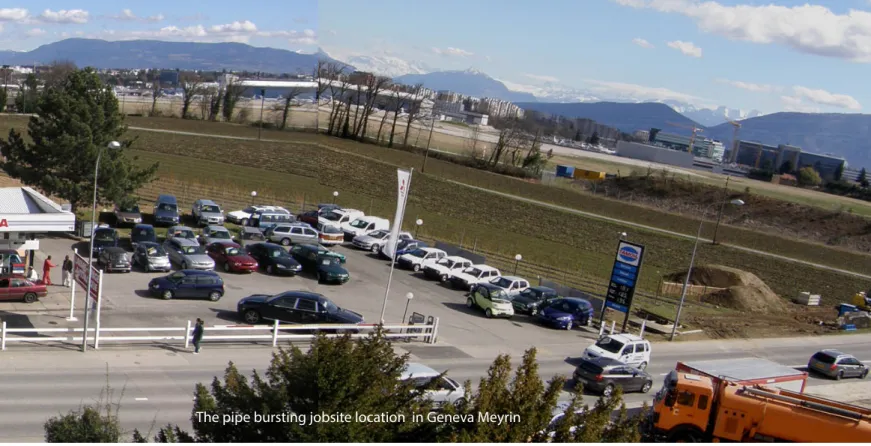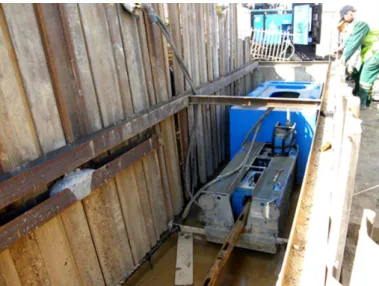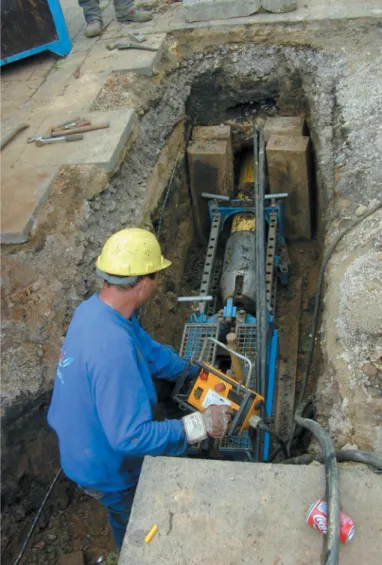Sustainable trenchless rehabilitation of supply pipelines
applying static pipe bursting or close-fit lining
Björn Freimuth,
Tracto-Technik GmbH & Co. KG, Germany
Leaking oil, gas or water pressure pipelines force utility com-panies to decide whether to repair, renovate or replace the defective pipes. The main decisive factors are the degree and type of damage, the sustainability of the method and the re-sulting rehabilitation cost. Modern trenchless pipeline reha-bilitation techniques minimize traffic disruption, noise emis-sion loads, dust and surface disruption, danger of damages to existing pipes and cables, intervention in ground water and soil, storage and transportation of the excavated soil. The choice of techniques ranges from punctual repair over par-tial renovation to complete renewal of the defective pipeline. 1. The Static Pipe Bursting method for pipe replacement Static pipe bursting with GRUNDOBURST is an approved method for trenchless pipe replacement. The old pipe (from ND 50 on) is destroyed underground and the new pipe, of-ten of larger diameter, is pulled in simultaneously. Defec-tive gas and water pipes (pressure pipes) as well as sewage pipes having major damages, e.g. breakage, incrustation, root infestation, misalignment, split sockets, tears, leakag-es, mechanical wear and tear, can be replaced. New pipes from the coil or short pipes of almost any material (plas-tic or metal) up to ND 1000 can be installed. Daily capac-ities of 150 – 300 m are possible. Applying the static pipe bursting method overcomes the necessity to patch repair or renovate the old pipe and a new pipeline with a service life of the up to 100 years in is installed perfect static conditions. Another major advantage when replacing supply pipes using static pipe bursting is that the method allows for increasing the pipe’s cross section the new pipe, i.e. the capacity of the
Figure 1: Schematic illustration of the pipe bursting method
Technique: Static pipe bursting Old pipe: Drinking water mains,
Grey cast iron ND 500 (20”) New pipe: Concrete with steel core OD 730
(29”) wall thickness 52.2 mm Pipe bursting
length: 450 m
Client: Geneva Public Utility Company (SIG)
Pipe bursting
contractor: PIASIO Geneva (COLAS), Switzerland
Remarks The old pipeline running beneath a petrol station had slight bends. 1.1 A major pipe bursting task in Geneva
Figure 2: The new concrete pipe to be installed
It was a mammoth task the PIASIO company, a subsidiary of COLAS SWITZERLAND, had ahead of them in Geneva Meyrin. Using a GRUNDOBURST type 2500 G (250 t pulling force), an over-aged and under-dimensioned 500 mm drinking water transport pipe made of grey cast iron had to be replaced by a 730 mm concrete pipe with a steel core, manufactured by BONNA. In Geneva, when extending public traffic routes, in this case for the highways network, it is the normal proce-dure to check all underground supply networks and, if nec-essary, renew or repair them. Generally, up to 5 years after completion of work on public roads the authorities are not allowed to excavate any subsequent excavations. The aim is
to prevent any danger areas, ugly road patchwork and con-stant repair procedures, which could cause further accidents on the extended highways network. This project was to cause as little disruption as possible to the adjoining proper-ty owners and traffic flow. This was also one of the reasons for the use of the pipe bursting replacement method, whereby the old pipe is broken and the new pipe, which is often of an increased diameter, is directly pulled into the existing pipe-line bore path. This replacement method is suitable for most pipe materials with the main advantage being the trenchless installation of a new pipe with a relevant, extended service life. In this case the renewal of the pipe stretched over sever-al sections with a totsever-al length of 450 m.
Jean-Michel BALMAT, responsible for “No-Dig” at COLAS SWITZERLAND commented: “This was an extreme advan-tage, especially for a task of this magnitude, which was also a first for us. The challenge was in the difficult replace-ment section of 125 m in length, which had slight bends laid at a depth between 1,70 m and 3 m further complicat-ed because the pipeline ran beneath a petrol station.” The adjoining property owners each received brochures in advance, giving them information and explanations regard-ing the Grundoburst pipe burstregard-ing method and the separate working steps. Numbered signposts were set up on the foot-path to indicate the progress of working steps. This exem-plary measure was highly acclaimed by the affected adjoin-ing property owners and was much appreciated by them. For the GRUNDOBURST 2500G a pit was excavated with a length of 10 m. With its enormous pulling force of 250 t old pipes from ND 300 to ≤ ND 1000mm can be renewed. The GRUNDOBURST rig, even with the highest pulling force de-mands, has to be stabilised securely inside the machine pit. A stabiliser made of steel reinforced concrete fitted to the front of the rig was specially produced to ensure its stability. Lowering and retrieving the special ladder-shaped Quick-Lock bursting rods, which a simply linked in place, was easily accomplished using a special fast attachment lifting device. Without taking into account all the preparatory and auxiliary work the actual bursting and pipe replacement process took just 3 days.
2. Replacement of a cast iron gas main with new PE pipes in Germany
Figure 3: The GRUNDOBURST2500G with 2500 kN (250 t) pulling force inside the construction pit
Figure 4: The pipe string with the 810 mm expander and the 600 mm cutting blades
Figure 5: The expander with the new pipe string attached is pulled in, the old concrete pipe is destroyed simultaneously
Technique: Static pipe bursting
Host Pipe: Gas main, Cast iron ND 200 (8”) New pipe PE with protection coating ND material: 225 (9”)
Pipe bursting
length: 200 m (657 ft)
Client: Dortmunder Energie- und
Wasserversorgung GmbH
Contractor: PAUL SPEECK GmbH, Germany Location of job City of Dortmund, district Nette,
site: Germany
The project was carried out in the sidewalk area of the Mengeder Street in Nette, a district of Dortmund, where 200 m (657 ft) of cast iron pipe ND 200 (8”) were to be replaced by a PE pipe ND 225 (9”) by means of trenchless installation. The crew of the local pipe bursting contractor, the comapny Paul Speeck GmbH, took the challenge to renew the com-plete service line in one single operation. The 12 m (39 ft) long PE pipes were laid out and welded together. Due to the confined space, the new pipe string had to be divided into three sections, forcing the crew to interrupt bursting twice for welding. The working pits for 6 house connections, the starting pit (6.00 x 1.00 m (19.5 x 3 ft) with 3.00 m (9 ft) inser-tion slots) and the exit pit (3.00 x 1.00 m (9 x 3 ft)) were exca-vated. After disconnecting the house service pipe and setting up the bursting rig Grundoburst 400G, pushing in the Quick-Lock rods could commence. By clicking the rods together without having to screw them together, the rod insertion phase was completed in only 75 minutes. The roller blade cutters, expander and new pipe were connected to the rods immediately thererafter. Bursting and pulling in was started.
The power and telecom cables lying directly above the new pipe forced the crew to position the roller blade cutters in front of the expander at 90°. During the pulling-in process, the cast iron pipe fragments collected in the intermediate pits were removed to prevent them from getting jammed when continuing the pulling operation. Thus work was halt-ed intermittendtly to enable risk-free removal of the shards from the pits. In spite of this interruption and the necessary pauses for welding, the complete pipe string was already pulled in the early afternoon. After 75 minutes, the expander with the new pipe string was pulled into the exit pit. In order to allow recovery of the bursting tools, the telescopic frame of the bursting rig was extended upon arrival of the bursting tools. Only after this, the roller blade cutter was pulled into the pit and removed. In the following, the operation was re-peated with the expander and the new pipe.
Figure 7: The rig’s telescopic frame is extended in order to recover the roller blade and the expander
Figure 6: The long pipe was lifted into the starting pit and connected there. The insertion slots in the background.
Roughly 20 minutes after completing the bursting opera-tion, the exit pit was completely cleared and the preparatory measures for the pressure test and the reconnection of the pipe were started. Pipe pulling was performed without nega-tive effects on the water line in the vicinity. With the expand-er OD 280 mm (11”) for the PE pipe ND 225 (9”), displacement of the soil and the host pipe could be maintained to a minor scale. A further remarkable fact: the depth of cover was only between 0.90 m (2.9 ft) and 1.10 m (3.6 ft). After a successful pressure test, all house connections were reconnected to the gas main on the following day.
2. The pipe reduction method for close-fit lining
Due to its high pulling force being optimally transferred, the GRUNDOBURST system can also be used for the renewal of pipes applying close-fit lining techniques such as the pipe reduction method. The reduction method is a relining tech-nique with the new pipe (liner) being of slightly larger di-ameter than the host pipe in which it is pulled leaving no annular space so that grouting is not necessary. The outer diameter of the PE new pipe (liner) is temporarily reduced using a mechanical device named reduction dye. After the PE liner has been pulled completely into the host pipe, the pulling force is removed and the PE pipe returns to its origi-nal diameter until it presses ’close-fit’ against the inside wall of the host pipe. This process is called “memory effect”.
Up to now hydraulic cable winches with up to 400 kN pulling force have been used to pull in the new pipe. Meanwhile the GRUNDOBURST system is also being used for the reduction method as pulling force and pulling speed are adjustable and the patended QuickLock bursting rods guarantee con-stant and even force transmission. Depending on the GRUN-DOBURST model pulling forces up to 2500 kN can be applied. The reduction method is applicable where static pipe burst-ing is not possible for whatever reason and suitable for the repair of circular cross sections of corroded, torn or leaking gas, water and sewage pipes from ND 75 up to approx. ND 1200 (3” to 48”).
2.1 Fast pipe renovation utilising the pipe pipe reduction method in Adelaide
Figure 8: Schematic illustration of the pipe r
eduction method
Technique: Reduction method Old pipe: Water main,
Concrete lined steel ND 600 (24”) New pipe: PE ND 560 (22”)
Pipe bursting
length: 250 m
Client: SA Water, City of Adelaide, Pipe bursting
TT’s Australian sister company TT Asia Pacific was contacted by leading pipe renewal specialist, Interflow, to discuss the benefits of its GRUNDOBURST pipe rehabilitation systems for an exciting project the company was commissioned to undertake on behalf of SA Water in the city of Adelaide, Aus-tralia.
The scope of renovation works was extensive at over 6 km, consisting of numerous pulls of varying lengths. The existing locking bar, 600 mm mild steel, concrete lined trunk water main was installed in 1898 and is the oldest locking bar steel pipe in South Australia. Due to the critical nature and age of the main SA Water had decided to renew the asset using a specialist close-fit lining method known as pipe reduction. The Marion/Holbrook Road projects in Adelaide were to be undertaken in challenging urban areas with high traffic vol-umes which meant a compact, versatile system was required to reduce space on site and ensure that heavily trafficked arterial roads into the city could be kept flowing with ease. Hence open trenching was virtually excluded and trenchless renovation using the GRUNDOBURST provided the optimum solution.
Moreover the GRUNDOBURST 1250G enables contractors to reduce costs due to fast set up times and quick installation speeds. All these advantages convinced the contractor and Interflow purchased the GRUNDOBURST 1250G system from TT Asia Pacific’s head office in Brisbane. The new product pipe chosen was to be an HDPE, ND 560, PE 100 pipe which was to be pulled through a reducing dye and the existing main under constant tension using the GRUNDOBURST un-til it reached the retrieval pit. Inside the old pipe the new pipe to returns naturally towards its original diameter until it presses closely against the inner wall of the existing main.
Initial above ground trials were undertaken by TT Asia Pacific and Interflow personnel to simulate the pipe behaviour prior to work commencing on the initial 250 m length of the pipe-line being renovated. Once complete, the GRUNDOBURST 1250 G was set behind extension frames in the ‘start pit’ and the complete string of QuickLock rods were inserted into the host pipe with ease and at an impressive speed. Dur-ing this time the reduction dye was set up and installed at the ‘retrieval pit’ and upon arrival of the pilot push head, a quick connection was made to the GRUNDOLOG tensile load measuring device and then to the pulling head was connect-ed to the product pipe. The GRUNDOLOG system enables the contractor to measure and record the pull data and tensile loads exerted onto the product pipe which could then in turn be downloaded and stored for future records if required. Figure 9: The pilot head prior to insertion into the 600 mm
mild steel main.
Figure 10: The new HDPE pipe ND 560, PE 100 entering the reducing dye prior to insertion.
The pull-in process with the GRUNDOBURST went very smoothly with the pulling forces encountered all being with-in the capabilities of the system/pullwith-ing rig and the pipe specifications. The complete string of PE product pipe was installed quickly and efficiently to the delight of all present on site.
TT Asia Pacific personnel, along with a product specialist from TT’s head office in Germany, were present during the initial installation process to assist with the technical trans-fer and were pleased to work alongside the experienced and professional crews at Interflow.
2.2 Close-fit lining of a gas mains using the reduction method in the UK
National Grid is one of the world’s largest utilitiy companies and the biggest gas and power supplier in the UK. TT-UK working together with the National Grid Gas specialist pipe repair division, PMC, and their contractor Morrison Utilities, has successfully been using the reduction method to refur-bish large diameter medium pressure gas mains. The existing 458 mm (18”) diameter cast iron main has been relined with a 469 mm SDR21 - PE80 pipe. The usual cumbersome 40 tons capacity hydraulic capstan winch was replaced with a special-ly adapted GRUNDOBURST 800G pipe replacement rig, fitted with the unique QuickLock ladder type rods for fast, reliable and safe handling. Due to some of the offset bends of the existing main, the QuickLock rod’s flexible joints easily over-came the associated pushing and pulling side load forces.
Up to now hydraulic cable winches with up to 400 kN pulling force have been used to pull in the new pipe. Meanwhile the GRUNDOBURST system is also being used for the reduction method as pulling force and pulling speed are adjustable and the patended QuickLock bursting rods guarantee con-stant and even force transmission. Depending on the GRUN-DOBURST model pulling forces up to 2500 kN can be applied. The reduction method is applicable where static pipe burst-ing is not possible for whatever reason and suitable for the repair of circular cross sections of corroded, torn or leaking gas, water and sewage pipes from ND 75 up to approx. ND 1200 (3” to 48”).
2.1 Fast pipe renovation utilising the pipe pipe reduction method in Adelaide
Installation speeds were as high as 180 metres in just 1 hour 35 minutes, but what was equally impressive was the ease of docking the new pipe in the specially constructed reduc-tion dye which together with the GRUNDOBURST’s push pull brake and fingers, ensured minimum pipe contraction both during the installation and reversion process. PMC have been delighted with the improved performance and produc-tivity using this innovative lining method and intend to use this technique in the future.
Technique: Reduction method
Old pipe: Gas main, Cast iron ND 458 (18”) New pipe: PE 80 SDR21, ND 469 (18.5”) Pipe bursting
length: 60 m
Client: National Grid / PMC, UK Pipe bursting
contractor: Morrison Utility Services, UK Remarks: Installation speed of 180 meters in
1h 35 min
Author
Björn FreimuthTRACTO-TECHNIK GmbH & Co. KG P.O. Box 4020 D - 57356 Lennestadt Tel. (+49) 2723 8080 Fax (+49) 2723 / 808180 E-Mail: export@tracto-technik.de Internet: www.tracto-technik.com





